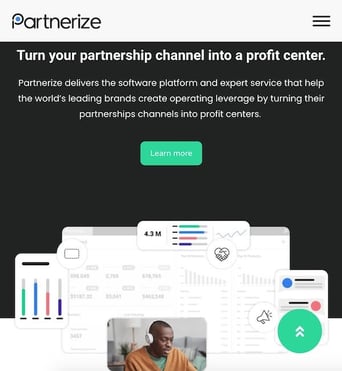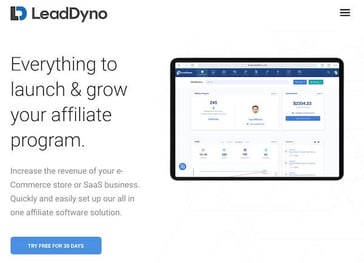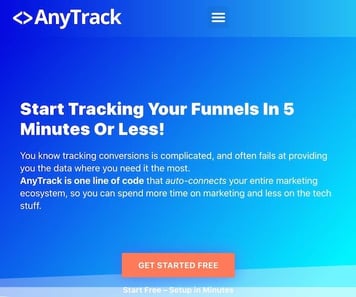A lot of companies have employee referral programs.
The concept is simple: If you refer someone who ends up getting hired, you earn a reward (typically a cash bonus). It’s a win-win – HR gets qualified candidates while employees feel motivated to assist in the search process.
The caveat we often see is that if the employee leaves the company within a certain window, the reward is null and void. Why give out a commission if the company won’t see a return on their investment? This is the same principle behind performance marketing.
Let’s dive into how performance marketing works, its benefits, and the tools you can use to implement it in your strategy.
With a traditional ad campaign approach, there’s no guarantee you will get a return on your investment. Once your ad launches, you can only monitor its performance and make adjustments.
The better and quicker you are at identifying areas for improvement, the better your chances of maximizing your return on ad spend (ROAS). But even seasoned media buyers can have unsuccessful campaigns if there’s misalignment between the campaign and the target audience.
Performance marketing places the power back into advertisers’ hands. Because you’ll only be paying when your goals are met, you accomplish three things:
- Your campaign is less risky
- There’s a guaranteed return on investment (ROI)
- You have better control over your ad spend
Is affiliate marketing the same as performance marketing?
Short answer: yes and no.
Think of affiliate marketing as a subset of performance marketing. The terms are often used interchangeably. However, performance marketing has grown to cover more than just affiliates over the years.
It also comprises campaigns that use pay-per-click (PPC) models, such as paid search.
How Performance Marketing Works
There are three key players needed to execute a performance marketing strategy:
- A publisher or an affiliate partner
- A conversion goal
- A commission rate
You, as the advertiser, will seek out an affiliate partner, which can be an influencer or publisher.
You must then outline your conversion goals. Let’s say your marketing objective for the quarter is to gain 10,000 leads. You can instruct your partner to direct traffic to your landing page and they will only earn a commission once a user has filled out the form.
Your next question might be, “How do advertisers know which users come from which affiliate?” Advertisers typically give each partner a specific link or code to track who is responsible for that conversion goal.
For instance, if I was an influencer and I partnered with Brandon Blackwood, I would share a 10% discount code “MARTINA10” with my followers to use at checkout when purchasing an item from the brand. Every time someone used my code to purchase, I would get a percentage of the sale.
Today, performance marketing is most popular with influencers, as studies show consumers trust influencers more than brands.
Before influencers, there were online publishers, and they are still big players in performance marketing. If you search “Top Performance Marketing Tools” on Google and land on a listicle, there’s a chance one of these tools may be an affiliate link.
How can you know for sure? Well, the Federal Trade Commission (FTC) now requires affiliate partners to disclose their partnerships to consumers. On Instagram, you’ll see the “paid partnership” tag, like this:
On websites and YouTube video descriptions, you’ll see affiliate disclosures, like this:
How To Create a Performance Marketing Strategy
1. Define your goals.
With any digital marketing campaign, establishing your objectives is key.
What do you want to accomplish? It may be general brand awareness, sales for your new product line, more leads, or something else.
Let’s go back to the world where I’m an influencer. Let’s say Brandon Blackwood just came out with a new product. Their marketing goal is to raise awareness of the new product and drive traffic to its product page to generate sales. In this case, their key metrics would be website clicks and unique sales.
Once you define your goals, you can develop your ad strategy and determine which metrics to track.
2. Identify your partners.
Now that you know what you want to achieve, start looking at online publishers and social media influencers whose audiences align with your own.
Identifying the right partners will require extensive research but it’s arguably the most important step.
Imagine working with a partner whose audience has no interest in your brand or product. Although they may interact at some level, they likely won’t convert.
And while you may not lose money, given that they would need to perform a particular action, it would be a waste of your time and resources.
After identifying who you want to work with, reach out to them to see if they would be interested in a partnership. During this step in the process, you’ll discuss your marketing goals, target audience, and commission rates. While some brands have standard rates, others may negotiate.
3. Generate and assign IDs.
You have solidified your partnerships. Now it’s time to get your links and codes ready to share with your affiliate(s).
The only way to correctly attribute an action to a particular partner is by assigning a custom ID, code, or UTM parameter.
It’s important to note that while you may do this manually at first, you’ll likely need to rely on a program to automate this process as you scale your business.
Top Performance Marketing Software
There are two main types of performance marketing software: those that focus on connecting advertisers with affiliate partners or publishers and those that monitor performance. Let’s go through some top tools in each category.
Performance Marketing Partnership Tools
1. PartnerStack
If you’re a SaaS company looking to develop a robust partner program, consider PartnerStack.
The platform, ranked in G2’s 2021 top 50 “Products for Sales,” helps brands recruit, onboard, and manage partners.
PartnerStack’s key features include custom forms and email flows to:
- Facilitate onboarding.
- Set up reward structures that are tailored to each partner.
- Develop an automated payment process.
The company offers custom pricing based on the needs and requirements of each business.
2. Partnerize
Want a simple and easy-to-use dashboard to manage your partners? Check out Partnerize.
Their dashboard gives you high-level data that allow you to gather information quickly and make decisions. Beyond that, Partnerize also customizes its features based on the industry, ensuring that every brand will have what they need to succeed in their performance marketing campaigns.
For pricing information, contact Partnerize.
3. TapJoy
TapJoy is designed for brands targeting mobile app users.
The software serves as an intermediary between advertisers and top mobile gaming publishers. Brands can track key conversion goals, like video completion and in-app purchases, and only pay money on the actions that meet their goals.
To learn about TapJoy’s pricing structure, you must contact the company.
Performance Marketing Tracking Tools
1. LeadDyno
One of the biggest struggles of working with affiliates is creating and tracking links and codes for each partner. This is where LeadDyno comes in.
LeadDyno gives brands the tools needed to grow a successful affiliate program. Standout features include:
- Automated links and codes for each partner
- Option to upload social media-ready content for affiliates to share
- A customizable affiliate portal
Pricing starts at $49/month and goes up to $79/month, for access to unlimited affiliates, extensive customer support options, and more. LeadDyno also offers custom pricing for businesses with over 7,500 unique monthly website visitors.
2. AnyTrack.io
With AnyTrack, attribution reporting is easier. You can consolidate data from multiple sources (like Google Analytics and Facebook Pixel) into one platform. From there, you can identify which strategies are working, and which ones require adjustments.
You can start using AnyTrack for free. Premium versions of the software are available, with pricing ranging from $50/month to $300/month.
3. Impact
The Impact tool streamlines the partnership process from initial contact to payout.
Anyone from an ambassador to a sponsor can be added to a brand’s “Partnership Cloud,” with tailored features for each type of partner.
Beyond the Cloud, Impact’s main features include:
- Partner search and discovery
- Fraud detection
- Partner management optimization
Get in touch with Impact to learn more about pricing.
Top Performance Marketing Verticals
Wondering which industries use performance marketing the most? According to a 2018 study by the Performance Marketing Association, advertisers in the retail sector spent the most in performance marketing – accounting for 50% of total spend. The financial sector followed with 35%, then a steep drop off to the travel industry with a 7% spend.
In terms of revenue, the sector with the highest revenue was retail at 73%, followed by travel with 14%. Industries like automotive, healthcare, and telecoms only accounted for 1% of the total performance marketing revenue in 2018.
However, despite having the big spend and highest revenue percentages, the retail industry didn’t offer the best ROAS. According to the report, the travel industry offered the best return with an 18:1 ratio, followed by the entertainment sector with a 15:1 ratio.
Any industry can have success with performance marketing. It’s all about collaborating with the right partners and setting up a robust program to reach your marketing goals.
from Irvine Business Signs https://ift.tt/3mFYP95
via Irvine Sign Company









